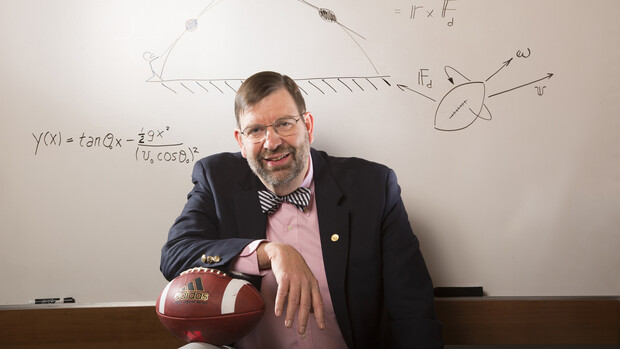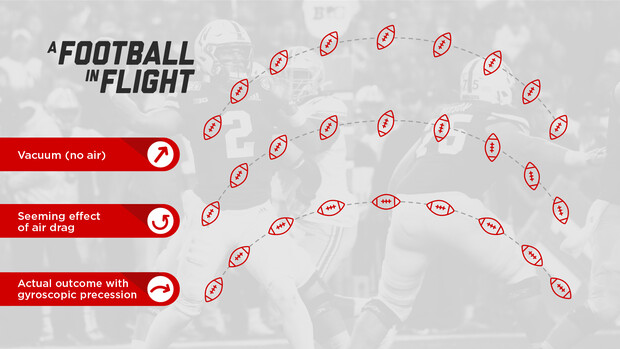Scott Schrage, October 5, 2020
Tipping point: After 20 years, Gay solves conundrum of football physics
Nebraska’s Tim Gay wrote the book on the physics of football. Really. It’s right there in the title, “Football Physics: The Science of the Game.”
How do Newton’s laws of motion apply to blocking and tackling? Ask Tim. How does altitude affect the flight of a football? Ask Tim. How can a coach calculate a cornerback’s optimal pursuit angle? Ask Tim.
Gay knows so much about it that he once became a Huskervision star by explaining it to sell-out crowds that filled Memorial Stadium, his talking head filling jumbotron screens for minute-long segments during Husker timeouts.
“That was a great gig,” he said. “I was teaching the biggest physics class in the world, and I didn’t have to do any grading.”

Word of the segments got out, eventually landing Gay in that most diehard of sports media outlets, The Wall Street Journal. A friend — Bill Phillips, who also happens to be a Nobel laureate in physics — saw the story and invited Gay to give a lecture on the topic at an annual gathering in Maryland. Gay agreed. When he was finished, Phillips raised his hand and rose to his feet.
“Bill is an extremely friendly guy,” said Gay, Willa Cather Professor of physics and astronomy at the University Nebraska–Lincoln. “But he has this reputation that if you’ve given a talk, and he stands up and asks a question, it means you’ve said something wrong. He’s going to get you for making a physics mistake. I thought, ‘Oh, crap. What did I screw up?’”
Nothing, actually. Phillips was just curious: When a quarterback launches a 50-yard bomb downfield, why does the front nose of the football — which points upward when it leaves the quarterback’s hand — tilt downward by the time it lands in the hands of a receiver?
“And I thought, ‘I don’t know! I don’t know,’” Gay said. “That’s the problem that intrigues physicists. Two players hitting each other with force (equal to) the weight of a baby whale is interesting, but the physicists already know that.
“They want to know why the ball does what it does, because that’s a subtler problem. It’s a harder problem. Anyone who has watched NFL Films or seen a good quarterback throw a long bomb knows what happens: The spinning ball just noses over so that its leading tip looks like it’s glued to the path that the ball’s following. But why?”
For about 15 years after, the question nagged at him. He came across some incorrect explanations and was able to debunk them.
“But I just couldn’t get any grip on it.”
It turned out that the question, like football itself, required a team effort. With the help of two theoretical physicists — his oldest college buddy, Willie Moss of the Lawrence Livermore National Laboratory, and Richard Price of MIT — Gay finally has his answer. And it was inspired in part by a toy from his youth.
The gyroscope of the problem
If a football were thrown in a vacuum, without any air to influence its flight, the phenomenon that so fascinated Gay wouldn’t exist. Instead, the ball’s nose would remain pointing upward even as gravity drew it back down to the field.
But introducing an atmosphere into the equation, or equations, means that physicists would expect to see notable changes in the flight of the ball as it sails through that air. The problem? What they expected is not what they saw.
Understanding why is a matter of forces and torques. Many of the forces are generated as the quarterback cocks his arm back, slings the ball forward and spins it off his fingers as he releases it. That motion propels the ball forward and up into the air, beginning the parabolic arc that the center of the ball will trace during a deep, well-thrown pass.
A tightly thrown spiral also rotates around the axis that runs from one tip of the football to the other, generating what’s known as angular momentum. When teaching the concept in class, Gay illustrates angular momentum by curling in the fingers of his right hand while sticking out his thumb. Whatever direction his thumb points is the direction of the angular momentum, with the curl of his fingers corresponding to the rotation of an object. The faster a football rotates, the greater its angular momentum — and in the case of a tight spiral, the direction of that angular momentum closely approximates the direction of the ball’s nose-to-nose axis.
As the arc of the ball’s trajectory dips below its initial launch angle, though, the torque generated by air rushing against it should, intuitively, cause the front end of the ball to pitch up so that it starts slowly tumbling backward, end over end.
“The reason it doesn’t happen is based on the concept of gyroscopic stabilization, and that’s where it gets difficult,” Gay said. “This illustrates how weird these kinds of problems are.”

A gyroscope is a tried-and-true go-to for instructors, including Gay, who want to demonstrate just how weird Newtonian physics can get. The classic gyroscope demonstration involves revving its axle up to hundreds of revolutions per minute, then placing one end of that axle in the loop of a suspended string while supporting the other end with a hand.
“All right-thinking people would say: What happens when you let the thing go? Well, I’m no longer supporting this end, so it’s just going to fall down and wiggle back and forth like a pendulum,” Gay said. “But that’s not what happens.”
The axle instead remains mostly horizontal, nodding down only slightly in acknowledgement of gravity. As it does, that unsupported end also begins moving in a horizontal circle, or precession.
Gay, Moss and Price knew that a well-thrown football, like the high-RPM gyroscope, possesses plenty of angular momentum. But with the aid of math and computer simulations, they came to a vital conclusion: The football can adopt a precession, too.
Torque generated by the angle between onrushing air and the football’s axis — the same torque that would seemingly send the ball into a reverse somersault — actually interacts with the ball’s angular momentum and gravity to produce the precession, Gay said. And it’s that precession, subtle enough to avoid detection even in slow-motion replays of 60-yarders uncorked by Terry Bradshaw, Patrick Mahomes and every quarterback in between, that ultimately explains the dip of the football’s nose.
“The interesting physics is that when you have a spinning object with angular momentum like that, and you then apply a torque to make it tumble in a different direction, it doesn’t go the way you think it’s going to go,” Gay said.
The irony — that a phenomenon witnessed and unquestioned by millions of football fans would emerge as such a thorny Newtonian physics problem — isn’t lost on Gay. In a way, he said, the fan in him may have wanted to resolve the problem as much as the physicist did.
“I’ve always been a huge football fan,” Gay said. “I bought all the NFL Films tapes, and I loved them. But the thing that really mesmerized me as a working physicist was seeing Warren Moon throw that ball, and it comes down the field, and it’s like it’s on a rail. You know, it’s just this perfectly smooth thing, and you think, ‘Wow. Why is it doing that?’ That’s really what’s been exciting for me, because it was a very hard problem to solve. I love working on problems that are hard to solve, I guess.
“But I’m glad we finally figured this out. It’s been keeping me awake nights for the last two decades.”
A paper detailing the findings of Price, Moss and Gay was recently published as an Editor’s Selection in the American Journal of Physics.





